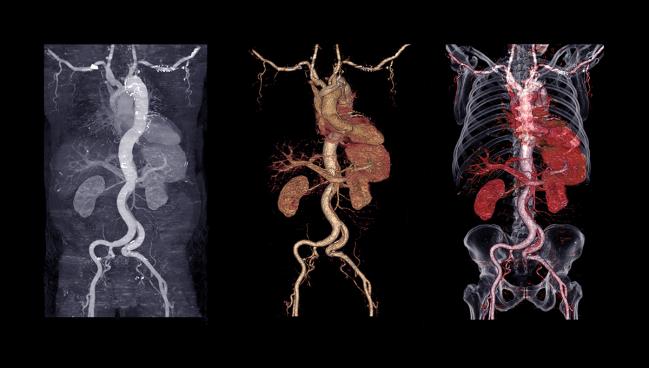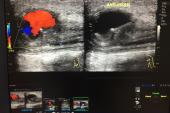Aortic Disease Deaths Tied to Modifiable Risk Factors, Japanese Data Confirm
A registry of more than 95,000 participants stretching across a quarter century points to smoking, BP, and lipid levels.

More than two decades’ worth of data from a large Japanese registry are shedding light on the factors that up the odds a person will die from aortic disease—most salient are heavy smoking, higher blood pressure, higher non-HDL cholesterol, and lower HDL cholesterol. Diabetes, on the other hand, is associated with a lower risk of aortic disease-related death, researchers found.
“The findings are expected to help guide cautious clinical management of patients with these risk factors, which partly overlap—but not completely—in accordance with those of other atherosclerotic cardiovascular diseases,” Ai Koba, MD (University of Tsukuba, Japan), and colleagues write in a paper published this week in the Journal of the American Heart Association.
Aortic disease—aneurysm and dissection—is rare but highly fatal, accounting for around 10% of sudden deaths, they say. In Japan, aortic disease was responsible for 1.4% of all deaths in 2017.
Janet Powell, MD, PhD (Imperial College London, England), commenting on the results for TCTMD, said they don’t come as a surprise. Usefully, though, the study “confirms in a Japanese population the risk factors for aortic disease are the same that we see in Europe and North America,” she said.
Powell cautioned, too, that in her view there are no clear messages here to guide practice, for two reasons. First, the main analysis contained a mixed bag of aortic aneurysm and dissection, which might have different risk factors. Additionally, the data go back to as early as 1993, she pointed out. For both cholesterol and blood pressure, “our treatment targets have been changing over that time period.”
Managing common [cardiovascular] risk factors will also be beneficial for the prevention of aortic death. Hiroo Takayama
Hiroo Takayama, MD, PhD (NewYork-Presbyterian/Columbia University Irving Medical Center, New York, NY), also providing outside perspective, told TCTMD that it’s quite interesting to see a study on this topic that’s exclusively focused on a Japanese population.
Anecdotally, as a surgeon who specializes in aortic surgery and who is originally from Japan, “I feel like aortic disease seems more prevalent in Japan. We tend to see more dissection and perhaps aneurysms, especially thoracic aortic aneurysms,” said Takayama, adding that the Japanese patients who develop these conditions tend to have a greater atherosclerotic disease burden than those he sees here in the United States.
“Overall, the findings are relatively confirmatory of the previous knowledge,” Takayama said, though two aspects of the study stood out to him.
The first was the finding that diabetes appeared to be protective. Takayama called this “thought provoking,” but he cautioned that there could be other explanations for the association, such as patients with diabetes dying from other causes before the age that aortic disease would typically develop. “We should be very careful in how we interpret this observation,” he stressed.
The other thing to note, Takayama continued, is that the people participating in the study were, on average, in their late 50s and 60s at the time of their enrollment. “That’s important,” he explained, because some types of aortic disease, such as aortic root aneurysms, tend to occur at a younger age in individuals who are otherwise healthy and may result from genetic disorders like Marfan syndrome. This study would not capture these earlier cases and so the risk factors identified by Koba et al apply only to the age group they studied.
That said, the study is “very new and unique” thanks to its prospectively collected, granular information for individual participants and its lengthy follow-up, Takayama specified, as well as the fact that the dataset is community-based rather than restricted to individuals known to have aortic disease.
Ibaraki Prefectural Health Study
For their analysis, the researchers turned to the Ibaraki Prefectural Health Study, a registry that prospectively collected information on 95,723 participants (66% women) obtained during municipal health checkups starting in 1993. One in five individuals were on an antihypertensive medication, while 8% of men and 4% of women had diabetes. Half of the men but just 5% of the women were smokers.
Over 26-year follow-up, 190 patients died of aortic aneurysm rupture (84 abdominal and 73 thoracic) and 188 of aortic dissection.
Multivariate analysis identified several factors that predicted individuals who would be more likely to die of aortic disease, whereas diabetes stood out as being associated with lower risk. Neither sex nor body mass index, triglyceride level, or alcohol use appeared to affect risk.
Predictors of Aortic Disease-Related Death
|
|
HR |
95% CI |
|
Systolic BP ≥ 160 mm Hg (vs < 120 mm Hg) |
1.61 |
1.00-2.59 |
|
Diastolic BP ≥ 100 mm Hg (vs < 80 mm Hg) |
2.95 |
1.95-4.48 |
|
Non-HDL Cholesterol ≥ 170 mg/dL (vs < 130 mg/dL) |
1.63 |
1.19-2.24 |
|
HDL Cholesterol < 40 mg/dL (vs ≥ 60 mg/dL) |
2.86 |
1.29-2.68 |
|
Smoking > 20 Cigarettes per Day (vs Never Smoking) |
2.46 |
1.66-3.63 |
|
Diabetes |
0.50 |
0.28-0.89 |
Death from aortic dissection versus aneurysm generally had the same predictors. However, only aortic aneurysm mortality was associated with high non-HDL cholesterol (HR 2.18; 95% CI 1.40-3.41) and high HDL cholesterol (HR 2.34; 95% CI 1.40-3.92), whereas no such relationships were seen for aortic dissection mortality. High diastolic blood pressure appeared to raise risk of dying from aortic dissection to a greater degree than it did the risk of dying from aortic aneurysm.
And finally, a closer look at thoracic versus abdominal aortic aneurysms (AAA) also showed some differences. High non-HDL cholesterol was not linked to greater mortality from a thoracic aortic aneurysm but was associated with quadruple the risk of dying from an AAA.
“To the best of our knowledge, the current study is the first to elucidate a variety of risk or protective factors against aortic diseases, including separate analyses for aortic aneurysm and for aortic dissection within the same cohort,” the authors conclude. The breadth of their data “made it possible not only to reinforce some of the findings of previous studies but also to introduce some novel findings,” in particular the differences seen by aortic-disease type.
For Takayama, this paper emphasizes the importance of measuring known risk factors associated with baseline health and disease. These data show that “aortic disease is in the spectrum of arterial diseases. [So in] managing these patients, from a cardiology or primary care standpoint there doesn’t seem to be anything too special. Managing common risk factors will also be beneficial for the prevention of aortic death,” he advised.
Caitlin E. Cox is News Editor of TCTMD and Associate Director, Editorial Content at the Cardiovascular Research Foundation. She produces the…
Read Full BioSources
Koba A, Yamagishi K, Sairenchi T, et al. Risk factors for mortality from aortic aneurysm and dissection: results from a 26-year follow-up of a community-based population. J Am Heart Assoc. 2023;12:e027045.
Disclosures
- The researchers, Powell, and Takayama report no relevant conflicts of interest.





Comments